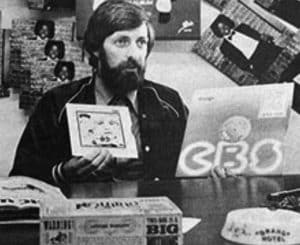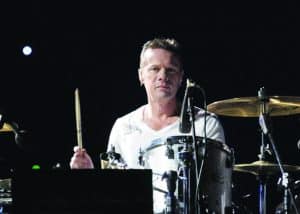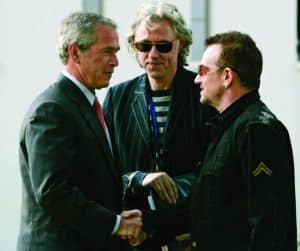U2 released ‘Songs of Experience’ before Christmas as a companion piece to 2014’s Songs of Innocence. Thematically, ‘Songs of Innocence’ was inspired by the band’s memories of their youth in Dublin in the 1970s with Bono describing it as “the most personal album we’ve written”.
‘Songs of Innocence’ touched upon these memories as perceived four decades on. The chances are slim that U2 will ever release the music they actually recorded in the 1970s – which also explored these themes – but at a time when they were raw and painful. A collection of primitive U2 demos – all recorded before their first official release in September 1979 – has been largely consigned to the vaults. Much to the dismay of avid fans, the black market bootleggers never managed to get their grubby hands on more than a few of them.
While they are no astonishing gems in the vaults, the tapes do at least provide a few insights into how the U2 sound evolved.
U2’s first demo session was the prize for winning a talent contest in Limerick in March 1978. While snippets from it have been broadcast during radio interviews with the band, the session has remained virtually out of bounds to the bootleggers; and even avid U2 websites profess ignorance about what was recorded. After four decades, Village will now finally – and exclusively – review U2’s first ever recording.
The CBS Sessions: ‘They Were Extremely Nervous And No One Was Expecting Miracles’
One of the judges at the Limerick talent contest was Jackie Hayden of CBS Ireland who became a critical figure in U2’s early success. The band’s bass player Adam Clayton felt Hayden “had a bit of flair and he wanted to sign Irish bands. The rest of the companies weren’t interested but he offered the best he could. He actually talked CBS into paying for our first demo tape”.
The session took place in April 1978 at Keystone Studios in Dublin. According to Adam, “It was our first time in the studio and I think his first time as producer. He told us to set up as we would for a live show and play the set. It was all done in two-track. He thought that was a good way to do a demo. Then he took the tapes off to London to try to talk them into signing us and they just laughed. The tapes were awful. We didn’t know at the time, we had nothing to compare them with”.
Hayden didn’t disagree. “After all”, he has said, “it was their first recording date, they were extremely nervous and no one was expecting miracles”.
HANG UP
The first song on the CBS session was called Hang Up. Like most of the original compositions, the lyrics evoke teenage angst. On this one Bono pleads on the phone to a soon-to-be ex-girlfriend not to “hang up/time is a cure/time can be found”.
UNKNOWN TITLE (possibly SHE’S MY GIRL)
The next track is also about teenage yearning but is far more interesting for a hint at how the U2 sound evolved. U2’s guitar player, The Edge, has explained that, “Adam is a very ostentatious sort of person, you know, very extravagant, so when he started playing bass he wasn’t interested in taking the bottom end of the sound spectrum at all. He wanted to be right up there in the mid ranges…In order to give the group any sort of clarity, therefore, I had to stay away from the bottom end of the guitar as much as I could. So, I tended to work around those ringing sounds”.

This track displays one of Clayton’s early midspectrum forays. It also features an unremarkable Edge solo in the typical do-it-yourself garage-pub rock style of the time.
STREET MISSIONS
Another version of this song was eventually released by the bootleggers. This version is not as polished as the later version and the Edge’s contribution is far more restrained here.
CONCENTRATION CAMP
This song grew to become one of the highlights of U2’s live set in 1979 as they edged closer to a recording contract. It contains a solo courtesy of the Edge and is propelled by a strong bass but is distinguished by Bono’s rapid-fire vocal delivery which is quite unlike any of the other numbers they recorded during the session. The theme is elusive. However, references to “schooldays” suggest that Bono was venting his anger against the educational system. During an interview 1979 he revealed that as a pupil he had reacted against excessive demands for “intelligence in school – everything that it seemed you were not was pushed at you and I had a bit of a heavy reaction against that’. Instead, as he states in this track, he wanted to “live his life tonight”.
UNKNOWN TITLE
The fourth song is a slow number with vague echoes of Shadows and Tall Trees which appeared on their debut album Boy in 1980. The theme is also dominated by descriptions of life on the streets of Dublin city.
INSIDE OUT
This forgotten composition, written in 1978, captures U2’s continuing evolution and innovation. It sways on Clayton’s ropey bass. Meanwhile, Bono sings about his feeling that he is “inside out” in the “modern world”. The bootleggers did manage to get a hold of it from tapes of an early radio interview with Bono during which it was afforded an airing.
BORN IN THE BACK IN THE STREETS
U2 just about stumbles to the end of this track with Bono making excuses: “Doesn’t matter if we make a mess of it, does it?”. They didn’t run through it again so this incomplete version may well be all that remains of this arrangement. Aside from references to being born in the back streets, the lyrics make little sense.
Bono admitted in 1979 that: “I never write lyrics until the last minute because they are constantly building as we work out the song. They build subconsciously because I find that I can write exactly what I want to write subconsciously, better than anything sitting down and trying. When the song is complete – and the idea is right – I then assemble the lyrics”.
The performance is awkward, highlighting a problem caused by the band’s then chaotic writing procedure which didn’t involve drummer Larry Mullen Jr until the final shaping of a new song. As Mullen once explained: “Adam and Dave and Bono used to write songs and say ‘Larry you come down at four and we’ll put the drums to it…’ I was coming down to put the drums on and I wasn’t seeing how the songs were being made”. One of the crucial developments in the future would be his closer involvement in the process.
NIGHT FLIGHT
This is the final original composition from the CBS session. Musically it is similar to Back in the Streets. On it Bono sings of the night “waiting for me” about “feeling free” and not “coming home”. When they came to the end of the piece, Bono commenting to Hayden that the group “could run through halfish numbers, but I don’t think there’s any point.” They didn’t bother which is now a pity.
NEON HEART
After a few minutes of chatter caught on tape, U2 played their version of the Boomtown Rats’ Neon Heart, a song that had featured during their live sets up to that point. According to Bono, “the main reason we used to do Neon Heart wasn’t because the Rats influenced us but because it was so easy to play. It’s just an unbelievably easy song to do”.
2-4-6-8 MOTORWAY
This track by The Tom Robinson Band was another track which had been part of U2’s repertoire since their earliest days together. During this fleeting performance, Bono nearly breaks out into laughter, probably due to nervousness.
Overall, the session was marred by the Edge’s tuning difficulties and the arrival of Larry Mullen’s father who hauled him away from the session.
The Keystone/Devlin Sessions: “This collection was tinny, full of pimples, and real”
U2 re-entered the recording studios on 1 November 1978, this time with Barry Devlin, vocalist and bass player with the legendary Horslips, as co-producer.
THE FOOL
One of the songs they recorded was called The Fool. Lyrically it is disjointed. As Bono told the Hot Press: “I like the sound of words as well – like in The Fool – (where) some of the lyrics don’t make sense but they are there for the sound of the words. Like “Live in an ocean a world of glad ice’.. That sentence came because of its actual colour”.
The Fool referred to in the title was one of Bono’s onstage alter egos, someone who breaks “all the rules… Just a fool, street jester”. It was apparently inspired by classroom readings of Shakespeare.
The Fool character was discarded by the time U2 started their recording career and is now virtually forgotten. However, five years after recording it, Bono was ambushed with a recording of it during a radio interview in the US. “I want to play something very unusual. Do you mind if I play a track of yours called The Fool?”, the DJ asked him. “I can’t even say that I mind because I can’t remember the song”, Bono replied. However, he soon recalled that it was the first song the band had composed in an “improvised way”. He added, “We were 16 when we made this. In fact, maybe even 15. Larry was 15, I was 16. [It was] half produced by Barry Devlin. Larry broke his leg. Or well he actually ran over his foot on a motorbike! He was in the studio. He was 15 years old and we were trying to make a demo and I remember Larry’s old man, that’s Larry Mullen senior, was like knocking on the door of the studio saying, I want my son back. I want him to be a jazz drummer. This is a very young U2”.
After playing the song, the interviewer commented that the song revealed a very young, very frantic U2 there. “So do you have garage roots?”. Bono nodded, “Oh yeah, we’re the original garage band from garage land. If we can do it anyone can do it”.
Not that it really matters but Bono was mistaken about being 16 when he recorded the song. He was born in May 1960 so he was 18 when the Keystone version was recorded.
SHADOWS AND TALL TREES
This was also recorded and later evolved into the version recorded on Boy in 1980.
STREET MISSIONS
This was one of the tracks recorded at the area CBS/Hayden session. A discernible punk influence pervades, especially at the start where the interaction between the Edge and Larry conjures up memories of the Sex Pistols first album.
Dave Fanning was a fan of this song. After a U2 performance at the Dark Space gig for the Hot Press he wrote that “Street Missions was great”.
Fanning has said of the session that “as pre1980s effervescent, frisky, streamlined rock-pop went, this collection was tinny, full of pimples, and real”.
Almost There, The 1979 Eamon Andrew Studio Sessions
FALSE PROFIT
U2’s next foray into the studio was at the Eamon Andrew Studios in Dublin in February, 1979, where they recorded an original composition called False Profit. The lyrics were a mid-mash of biblical allusion and even contained bizarre reference to “20th century boy”, a phrase undoubtedly borrowed from the recording of the same name by the late Marc Bolan, one of the 1970s glitter rock stars. Bolan, who sang and played with T Rex, was one of Bono’s earliest idols. He even claimed, “I’ve always said there’s only one man I fancied as a pre-pubescent, and that was Mark Bolan”.
TWILIGHT
This track would later evolve into the B-side of U2’s second single, Another Day come a year later. This version was recorded over a period of about 15 minutes without a producer. The result was raw but provides a glimpse of what was to come. It is a perfect example of the interplay between Clayton’s animated base and the Edge’s ice-pick blues style.
JOHNNY SWALLOW
This is an early version of the ambient recording that appeared on the B-side of U2’s 1981 single Fire. It is quite unlike anything they had released up to this point and was a pointer to their appetite for experimentation that would become much more evident later on. Lyrically, there are references to “feeling a fire” which, like the single Fire, undoubtedly drew on the Bible for inspiration.
They also recorded Another Time, Another Place which appeared on ‘Boy and The Magic Carpet’ (which have popped up on bootlegs of the National Stadium 1980 gig) and Alone in the Light, a snippet of which can be heard on Youtube.
There were further recordings for CBS later in the year which led to the release of the band’s first official release U23. One of the tracks saved from obscurity during these sessions was The Dream Is Over; all of the other tracks recorded were eventually released in one form or another.
The Dave Fanning Sessions: Preserving a few more nuggets
Last year, Ian Wilson who recorded the Dave Fanning sessions for RTE, delved back into the vaults and found a few recordings of demos that never made it onto official releases, nor even B-sides. They included Jack In a Box and Trevor.
Larry Mullen, U2’s Magical Ingredient
Larry Mullen has described his drumming style as ‘unteachable’. “I had a stage, too, when a guy tried to teach me jazz drumming”, he has explained. “This teacher was really into Steven Gadd: Steve Gadd was his idol. I think Steve Gadd is a great drummer, but this teacher would play Gadd’s records and tell me to play like that. I was rehearsing with U2 as well then, so I gave it up. I just couldn’t sit there and imitate someone else”. Still, the taste of all that jazz can only have broadened his range and led him to filling in and adding drum rolls rather than laying down a predictable rock beat for U2 to follow as they strove to create what would become their distinctive sound.
Mullen’s adaptability, inventiveness and his overarching sense of timing was crucial to the development of U2’s sound. The combination created the space for the dynamic between Clayton and The Edge to flourish instead of suffocating it.
Brian Eno, the legendary record producer, has described Mullen’s instincts as ‘staggering’. Eno, who produced many of U2’s best records, has described how Mullen once insisted in the studio that a click track the band was using was a fraction of a beat off of the band. After he left the studio, Eno discovered it was askew by six milliseconds.

There are intriguing similarities between Mullen and Charlie Watts of the Rolling Stones. Watts not only enjoys a rare talent for timing but also had to dance around the domineering style of one of the guitar players in his band; in his case it was Keith Richards, who has played rhythm guitar for the Stones since 1962. When Bill Wyman, the original Stones’ bass player, was asked to explain the band’s characteristic sound, he answered that it was ‘probably a matter of personality”. He described how Richard ‘was a very confident and stubborn player’. Again, timing was everything. ‘Every rock and roll band follows the drummer, right?”, Wyman asked rhetorically. “If the drummer slows down, the band slows down with him or speeds up when he does. That’s just the way it works— except for our band. Our band does not follow the drummer; our drummer follows the rhythm guitarist, who is Keith Richards. Immediately you’ve got something like a 1/100th of a second delay between the guitar and Charlie’s lovely drumming… So with Charlie following Keith, you have that very minute delay. Add to that the fact that I tend to anticipate a bit because I kind of know what Keith’s going to do. So that puts me that split second ahead of Keith. When you actually hear that, it seems to just pulse…”.
Of course, the U2 formula is not the same as that of the Stones, but the adaptability and innate timing skills of their gentlemanly drummers may very well be the ‘unteachable’ ingredient behind their enduring success. Incredible as it may seem now in the very early days of U2 some of the suits at CBS failed to recognise the promise in Mullen’s drumming and hinted that he should be dumped. The rest of U2 knew better and would hear nothing of it.
by Joseph de Búrca

